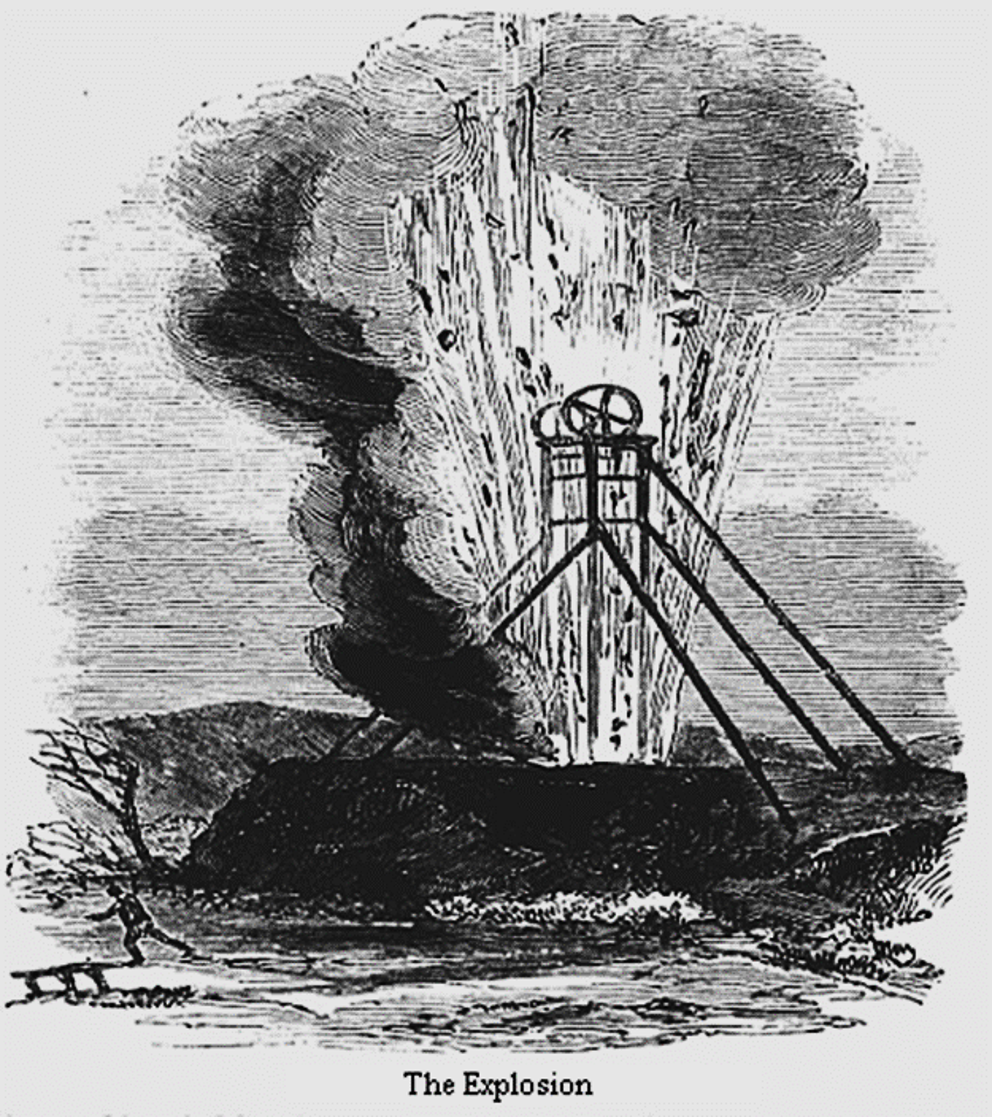Coal Mining & the Victoria Pit Disaster
The Explosion, Saturday 15th March 1851

'On Saturday morning, a fearful explosion occurred in the Victoria coalpit, belonging to the Messrs. Coatts of Paisley, situated at Nitshill, a few miles from Glasgow. The explosion took place about 20 minutes to 5 o'clock and the report was so loud that it was distinctly heard at Paisley. The whole neighbourhood, of course, was alarmed, and on the people rushing to the pay-mouth, it was found that one of the cages, which had descended a few fathoms, had been blown up the shaft to probably the height of the pit framing, some 30 feet above ground, and after jerking the rope off the pulley at the top of the framing, fell with a double fold of rope under it. The banksman had not arrived when the accident occurred, and it is uncertain whether any one was in the cage at the time or not. Some said there were two men, but, if so, they must have been precipitated down the pit, as their bodies have not been recovered. The Victoria pit, in which the explosion took place, is the deepest in Scotland, being 1,050 in depth at the down-cast shaft, which is situated about the centre of the southern edge of the workings, from whence the inclination of the strata tends upwards to the north, at an angle of about one foot in five, so that at the up cast shaft or pit, which is about a quarter of a mile distant from the working pit, the workings are only 780 feet below the surface.’
(From the Glasgow Herald, Monday 17th March 1851)
Colliery explosion - great loss of life
‘On Saturday morning, the most fearful explosion occurred in the Victoria coal pit, belonging to the Messrs Coats of Paisley, situated at Nitshill, a few miles from Glasgow. The place where the blast has evidently been most destructive it is in the direction of what is called the Free Trade pit, which is about half-a-mile from the mouth of the Victoria. The Free-trade pit, we may explain, is used merely as an air shaft for the Victoria, and from its dense volumes of smoke are still issuing, having the smell which usually arises from burning materials. The report of the explosion was heard at a distance of several miles.
The connecting particulars which we have learned regarding this unhappy affair , may be summed up as follows: - the colliers, to the number of upwards of 60, went down in successive gangs about 3 am on Saturday. They were accompanied by Peter Hammond, the assistant underground overman, who had also the charge of the ventilation of the pit, and whose invariable practice it was to go through the workings every morning, before the colliers commenced. Hammond is spoken of to us as an exceedingly steady and shrewd man, who had been accustomed to mines all his life, and one in whom the workmen had the most perfect confidence. By the return of one of the cages which had brought down at day men, a small number of men who had been working in the pit during the night were conveyed to the surface. Hammond, we are informed, either used or was possessed of a Davy lamp, which he used in his daily examinations, but the colliers carried only the common lamp, and it was often a matter of complaint with them that the current of air in the pit was so strong that it blew out the lights. In this state of matters - 60 men being below and understood to be at work, while a large number of drawers and trappers were standing at the pit head waiting their turn to be taken down, the appalling explosion took place, about 20 minutes before 5 a m.. Many of the people threw themselves on their faces, and the debris showered on their bodies, although nothing came up large enough to hurt them. It is estimated that the explosion continued two minutes and gave several successive shocks or heaves - the first by far the loudest - until the pent-up vapour had expended itself, and all was still.’
Scotsman, Wednesday 19th March 1851
Coal-pit Explosion at Paisley - Sixty-one Lives Lost
'Shortly before 5 o'clock a.m., a fearful explosion took place at a coal-pit near Nitshill, between two and three miles from Paisley, by which 61 human beings lost their lives. The Victoria pit, in which the explosion took place, is the deepest in Scotland, being 1050 feet in depth at the downcast shaft, and the workings extend over an area of 70 acres, of which, however, a large part were at this time discontinued, and the access cut off by brick walls; so that the air from the downcast shaft was carried past them to the present workings, a distance of nearly one-third of a mile.
Being "pay Saturday," a larger number of the men had commenced work at an earlier hour than is usual on other days. The explosion took place about 20 minutes to 5 o'clock with a report so loud that it was heard distinctly at Paisley. The whole neighbourhood was alarmed; and on the people rushing to the pit-mouth, it was found that one of the cages, which had descended a few fathoms, had been blown up the shaft to the height of the pit framing, about 30 feet. It was now ascertained that 63 men and boys were in the pit, and little hope could be entertained that any of them would escape. Many of the workmen were Irish strangers; but many had wives and children in the villages in the neighbourhood. The distress of these poor people may be imagined.’
[From the Annual Register, 1851]
‘The works of the interior of the mine had been so much injured by the explosion, and the distance to be traversed from the downcast shaft was so great, that it was not until Sunday evening that two men were able to reach the workings, where they, contrary to expectation, found two living men, almost exhausted by want of food, terror, and bad air, but uninjured in person; all the others, 61 in number, had perished by the terrific blast!
Most of the bodies, when found, were blackened and swollen by the fire, and altogether so much mangled that it was necessary to send down coffins for the reception of the remains previous to their being brought to the surface. Most of the poor fellows had been evidently surprised at their work, or when just about to commence it. A group of eight dead men were found sitting with their tobacco-pipes in their mouths, as if they were taking their morning's smoke, and some of them had just thrown off their jackets, previous to taking the pick in their hands.
The Victoria pit is what is called a fiery one. The coal is used principally for furnace purposes and emits a large quantity of inflammable gas in the workings. Ordinary oil lamps or candles are, notwithstanding, employed by the miners ; and so large an escape of inflammable gas goes on in the face of the workings, that a candle, held close to the wall when the air-current is sluggish, will cause a sheet of flame to flash along the whole face where the coal is being dug out. No artificial mode of producing ventilation by a current of air is adopted in the pit. The air finds its way down the downcast or working shaft, and after traversing round and through the workings for perhaps miles, finds its way to the up cast shaft, which it ascends, owing to the heat it may have acquired whilst wriggling along amongst the workmen.
A very large subscription has been obtained for the relief of the widows and orphans.’
[From the Annual Register, 1851]
